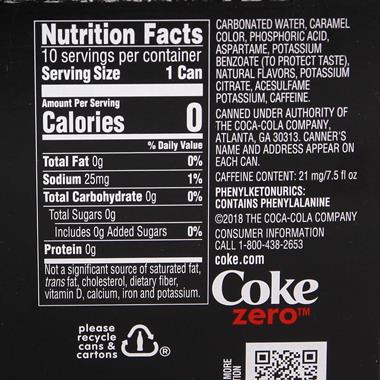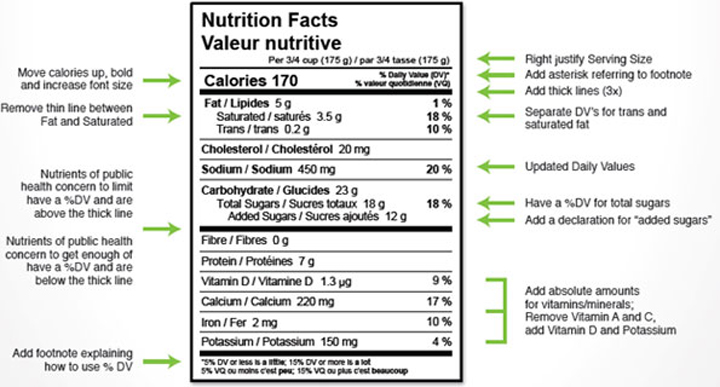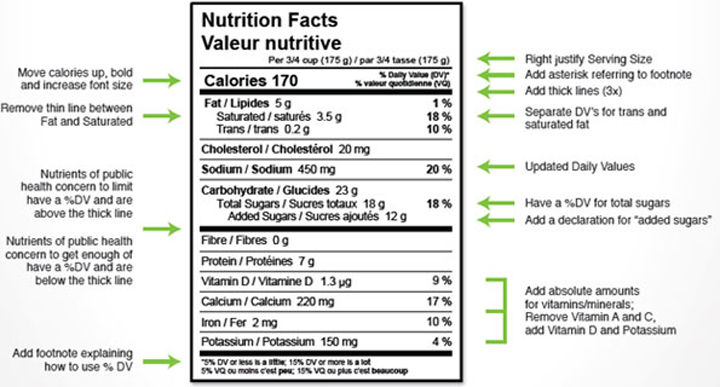43 how to read nutrition facts labels canada
Understanding a food label - Canadian Food Inspection Agency The Nutrition Facts Table must list the 13 core nutrients: fat, saturated fat, trans fat, cholesterol, sodium, carbohydrates, fibre, sugar, protein, vitamin A, vitamin C, calcium and iron. A simplified version of the Nutrition Facts Table may be used if the product does not contain certain nutrients. How to Read Nutrition Facts Label - Food Network When you take a look toward the top of the Nutrition Facts label you'll see the servings per container and the serving size. Pay close attention to the serving size. All of the information on the...
Canada Nutrition Facts Templates - Ingredients List Label | ESHA Canada Standard Nutrition Facts Label This is the most common label format. This format is recommended unless there isn't enough continuous vertical space to do so. If there is not enough space, you may use the side-by-side (split) format and place the footnote to the right of the label.. Canada Tabular Nutrition Facts Label

How to read nutrition facts labels canada
Presentation of the Nutrition Facts Table - Food labels - Canadian Food ... A Nutrition Facts table (NFt) must use a single non-decorative "sans serif" font [B.01.450 (3) (a), FDR ]. "Serif" is a slight finishing stroke or projection off the main stroke of a letter, for example " S " contrasted with "S". Sans serif fonts are those fonts that do not have finishing strokes on the letters. How to Understand and Use the Nutrition Facts Label | FDA When looking at the Nutrition Facts label, first take a look at the number of servings in the package (servings per container) and the serving size. Serving sizes are standardized to make it easier... What is in a Nutrition Facts Label? | Gordon Food Service Canada The nutrition facts table looks the same on most foods, which makes it easy to find and easy to read. All of the information in the nutrition facts table is based on a given amount of food. This amount is always found at the top of the table. That's the first component of the table you should look at. You need to know what amount of food the information you're looking at refers to. Unless the box is for a single serving, such as a microwave dinner, rarely is the information referring to ...
How to read nutrition facts labels canada. How To Read Nutrition Fact Labels - FitWatch So, here's my four-step crash course on reading the Nutrition Facts label to help you understand what it all means. Step 1: Look at the Serving Size The absolute most important part of the food label is to note the serving size. Manufacturers often strategically choose the serving size to make the rest of the label look good. Nutrition labels: Finding out about the food you eat All information on the nutrition label is based on a specific amount of food called the serving size. When you compare products, ensure that the serving sizes are the same. When comparing foods, use percent daily values (% DV) to find out if a food has a little or a lot of a nutrient. Understanding food labels - Canada.ca Learn about nutrition facts tables, serving size, list of ingredients, % daily value and nutrition claims. ... Skip to "About government" Language selection. Français fr / Gouvernement du Canada. Search. Search Canada.ca. Search. Menu Main Menu . Jobs and the workplace; ... Food labels, nutrition facts tables, serving size, ingredients ... 4 Steps to Reading the Nutrition Facts Table Step 4: How to Read the Bottom of the Nutrition Facts Table. The vitamins and minerals listed at the bottom of the table are also straightforward. The new labels will list potassium, calcium, and iron. Yes, potassium will drop from the middle of the table to the bottom, and both vitamins A & C will become optional.
Learn how to decode a nutrition facts label | Canadian Living Here's how: The standard label criteria states that calorie count and 13 core nutrients must always appear in the same order to make the nutrition facts easy to identify and use. Those nutrients include fat, saturated fat, trans fat, cholesterol, sodium, carbohydrates, fibre, sugars, protein, vitamin A, vitamin C, calcium and iron. How to read nutrition facts labels - Diabetes Care Community 5 easy steps to reading a Nutrition Facts Table. 1.Look at the serving size. Compare the serving size on the package to the amount that you plan to eat. If you eat the serving size shown on the Nutrition Facts table, you will get the amount of calories and nutrients that are listed. (Of course, if you eat more, then your calories will go up). Understanding Food Nutrition Labels - American Heart Association Remember that the information shown in the label is based on a diet of 2,000 calories a day. You may need less or more than 2,000 calories depending upon your age, gender, activity level, and whether you're trying to lose, gain or maintain your weight. When the Nutrition Facts label says a food contains "0 g" of trans fat, but includes ... How To Read Nutrition Facts Labels - Canada's Nutrition Coach Nutrition Facts Labels are helpful and easy to use, but be diligent and look at the proper information. To quickly summarize: Check the calories pre serving to determine if the caloric load of the product fits your goals; Minimize trans fats and sugars, and if you have a pre-existing health problem, minimize cholesterol and sodium as well
How to Read Nutrition Facts Labels - Urban Mommies Canada Nutrition wants you to be comfortable - not only figuring out Nutrition Facts for yourself, but so that you can teach good nutrition education to your children as well! Have no fear - with these few pointers, you'll become a Nutrition Facts reading NINJA in no time. #1 - Start with the serving size. How to Read Nutrition Labels in Canada | Beyond Diabetes Nutrition ... Nutrition labels can be a great tool for helping you make food choices that align with your health goals. But it can feel overwhelming trying to compare everything (especially while we are still in the transition period between the old to new label formats). Here are some basic steps to being a label reading connoisseur the next time you are grocery shopping. Start with Serving Size ... 3 Ways to Read Nutrition Facts on Food Labels - wikiHow 2. Eat less than 100% of your daily value in fat every day. Keep your fat intake under 100% of the recommended value. 65% is a healthy number to shoot for, but you may want to consume a little more if you're low on energy or trying to build muscle mass. How to Read a Nutrition Facts Label | The Beachbody Blog "However, when you read the nutrition label, important information is revealed." Think about it this way: The front of a package is marketing. The words on the front, "healthy," "fat-free," "naturally sweetened," sound good, but the real information is on the back or on the side.
How to read a food label - Concordia University There are three main kinds of information on a label: the Nutrition Facts panel, the ingredient list and the nutrition claim. How to read a Nutrition Facts panel. The Nutrition Facts panel lists the serving size, amount of calories per serving and the amount of 13 nutrients per serving. It can be used to compare two different brands of a food product. A Nutrition Facts panel for a granola nut bar is used as an example in the image below. Here's what to look for:
How to Read Nutrition Labels Like a Pro | Reader's Digest Canada How to Read Nutrition Labels in Canada, Line by Line Serving Size. When it comes to learning how to read nutrition labels, the first place to look is the serving size. Located directly under the "Nutrition Facts" title at the top of the list, it displays the amount of fat, calories and nutrients you're consuming.
How to Properly Read a Nutrition Facts Table Step 4: Bottom of the table (e.g. vitamins & minerals) The vitamins and minerals listed at the bottom of the table are also straightforward. The new labels will list potassium, calcium, and iron. Yes, potassium will drop from the middle of the table to the bottom, and both vitamins A & C will become optional.
Understanding Food Labels in Canada - Unlock Food Step 3: Look at the percent daily value (% DV) The percent daily value (% DV) shows you if a food has a little or a lot of a nutrient. 5% DV or less is a little of a nutrient. 15% DV or more is a lot of a nutrient. The % DV is meant to act as a benchmark to determine if that food is high or low in a certain nutrient.
Use food labels - Canada's Food Guide Benefits of using food labels. Food labels provide information you can use to make informed choices about foods and drinks at the grocery store and at home. Food labels can help you: compare and choose products more easily. know what ingredients a food product contains. choose products with a little or a lot of the nutrients that are of ...
How To Read & Understand Canadian Food Nutrition Labels Reading Nutrition Labels Now that you are well-versed in the different types of calories, fats and carbs, you can start to apply this knowledge to reading nutrition facts labels. Below is an outline for how to read these labels in stages and what to look for at each stage: 1. Serving Size - This is often overlooked, but worth noting. Something could appear great, but you might need to multiply all the nutrition facts by 2 or 3 for the actual amount you plan to eat.
Nutrition facts tables - Canada.ca A nutrition facts table can also be used to: learn about a food's nutritional value (calories and ...
PDF Label Reading the Healthy Way - Alberta Health Services Nutrition Facts table . The Nutrition Facts table on the food label gives you information on serving size, calories, and at least 12 different nutrients. Use the Nutrition Facts table to compare similar foods. The serving size is listed at the top of the Nutrition Facts table. All the information in the table is based on this amount of food.
How To Read Food and Beverage Labels - National Institute on Aging The U.S. Food and Drug Administration (FDA) requires a Nutrition Facts label on most packaged foods and beverages. At the top of the Nutrition Facts label, you will find the total number of servings in the container and the food or beverage's serving size. The serving size on the label is based on the amount of food that people may typically ...
The New Nutrition Facts Label | FDA The U.S. Food and Drug Administration (FDA) has updated the Nutrition Facts label on packaged foods and drinks. FDA is requiring changes to the Nutrition Facts label based on updated scientific ...
What is in a Nutrition Facts Label? | Gordon Food Service Canada The nutrition facts table looks the same on most foods, which makes it easy to find and easy to read. All of the information in the nutrition facts table is based on a given amount of food. This amount is always found at the top of the table. That's the first component of the table you should look at. You need to know what amount of food the information you're looking at refers to. Unless the box is for a single serving, such as a microwave dinner, rarely is the information referring to ...
How to Understand and Use the Nutrition Facts Label | FDA When looking at the Nutrition Facts label, first take a look at the number of servings in the package (servings per container) and the serving size. Serving sizes are standardized to make it easier...
Presentation of the Nutrition Facts Table - Food labels - Canadian Food ... A Nutrition Facts table (NFt) must use a single non-decorative "sans serif" font [B.01.450 (3) (a), FDR ]. "Serif" is a slight finishing stroke or projection off the main stroke of a letter, for example " S " contrasted with "S". Sans serif fonts are those fonts that do not have finishing strokes on the letters.














Post a Comment for "43 how to read nutrition facts labels canada"